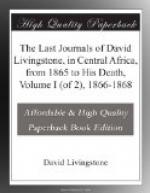We saw the last of the flanking range on the north. The country in front is plain, with a few detached granitic peaks shot up. The Makoa in large numbers live at the end of the range in a place called Nyuchi. At Nyamba, a village where we spent the night of the 5th, was a doctoress and rain-maker, who presented a large basket of soroko, or, as they call it in India, “mung,” and a fowl. She is tall and well made, with fine limbs and feet, and was profusely tattooed all over; even her hips and buttocks had their elaborate markings: no shame is felt in exposing these parts.
A good deal of salt is made by lixiviation of the soil and evaporating by fire. The head woman had a tame khanga tole or tufted guinea-fowl, with bluish instead of white spots.
In passing along westwards after leaving the end of the range, we came first of all on sandstone hardened by fire; then masses of granite, as if in that had been contained the igneous agency of partial metamorphosis; it had also lifted up the sandstone, so as to cause a dip to the east. Then the syenite or granite seemed as if it had been melted, for it was all in striae, which striae, as they do elsewhere, run east and west. With the change in geological structure we get a different vegetation. Instead of the laurel-leaved trees of various kinds, we have African ebonies, acacias, and mimosae: the grass is shorter and more sparse, and we can move along without wood-cutting. We were now opposite a hill on the south called Simba, a lion, from its supposed resemblance to that animal. A large Mabiha population live there, and make raids occasionally over to this side for slaves.
6th May, 1866.—Tsetse again. The animals look drowsy. The cow’s eye is dimmed; when punctured, the skin emits a stream of scarlet blood. The people hereabouts seem intelligent and respectful. At service a man began to talk, but when I said, “Ku soma Mlungu,”—“we wish to pray to God,” he desisted. It would be interesting to know what the ideas of these men are, and to ascertain what they have gained in their communings with nature during the ages past. They do not give the idea of that boisterous wickedness and disregard of life which we read of in our own dark ages, but I have no one to translate, although I can understand much of what is said on common topics chiefly from knowing other dialects.
7th May, 1866.—A camel died during the night, and the grey buffalo is in convulsions this morning. The cruelty of these sepoys vitiates my experiment, and I quite expect many camels, one buffalo, and one mule to die yet; they sit down and smoke and eat, leaving the animals loaded in the sun. If I am not with them, it is a constant dawdling; they are evidently unwilling to exert themselves, they cannot carry their belts and bags, and their powers of eating and vomiting are astounding. The Makonde villages are remarkably clean, but no sooner do we pass a night in one than the fellows make it filthy.




